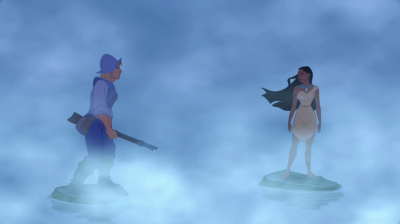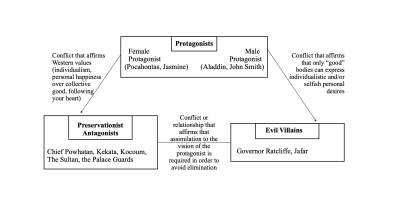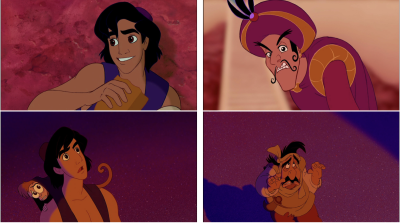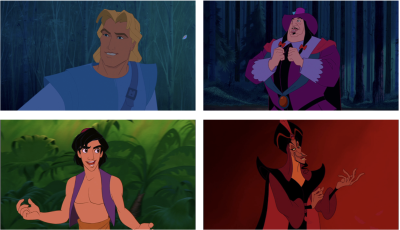
Originally presented at the Annual Conference of the Mid-Atlantic Popular & American Culture Association. November 2019, Pittsburgh, Pennsylvania
As many Western children’s first experience with pop culture, Disney films are uniquely situated as sites of meaning. Examining their narrative and visual dynamics can illuminate how these films re/produce mimetic vocabularies that shape cultural conceptions of who or what constitutes and defines “the good.” Using Aladdin (1992) and Pocahontas (1995) as case studies, this paper explores the political, racial, aesthetic, moral, and gender dynamics operating within these two films, arguing that Aladdin and Pocahontas utilize a triangulated conflict and visually Orientalizing relationships to construct a scopo-linguistic framework that upholds a moral-aesthetic vision that defines the white and Western (literally or analogically) as good, central, and beautiful, and the “Other” as evil, peripheral, and ugly. Through this framework, values and bodies that conform to the hegemonic ideal are coded as good, and values and bodies that diverge are coded as evil or disposable unless they can achieve assimilation to the ideal.
Although these films purport to pull from Arabic or Native American traditions, the bodies, cultures, images, and relationships depicted in Aladdin and Pocahontas are not based in the geography, culture, or history of Middle Eastern or Indigenous American peoples, nor are they attempting to be; as Edward Said writes in Orientalism, “we need not look for correspondence between the language used to depict the Orient and the Orient itself, not so much because the language is inaccurate but because it is not even trying to be accurate.” 1 At the same time, these images both come from and reproduce the longstanding cultural project of whiteness, which seeks above all to keep itself in power. In this way, the bodies, cultures, images, and relationships represented in Disney films are based in and reflect the stereotypes, presuppositions, and narratives that whiteness has constructed. While these images are “not even trying to be accurate” to Middle Eastern or Indigenous American cultures and peoples, they are accurate to white Western cultural perceptions of Arabic and Native American cultures and peoples. Therefore, the bodies, cultures, images, and relationships of these films waver in a space of in/accuracy, as they simultaneously reflect, first, the stereotypes, representations, and narratives whiteness has constructed/constructs, and perceives; second, the gap between these narratives and the lived experiences and histories of people of color; and third, through their conspicuous absence, those experiences and histories as well. Thus, this feature takes these two films as examples of the construction of cultural values and who or what is good and has access to the good. Through visual relationships of difference alongside narrative-character relational structures, Aladdin and Pocahontas subtextually argue for the superiority of whiteness and Western value systems. 2

Aladdin and Pocahontas utilize a triangulation of protagonist(s), villain, and preservationist antagonists to validate white cisheteropatriarchal “good bodies” and Western “good values” (Fig. 1). By setting the protagonist against two different types of opposing forces, the films both reiterate Western individualism as morally preferable to tradition and collectivism and make implicit arguments about who can vocalize and act on what kind of desires while retaining positive moral positioning. Within these two films’ moral universes, the preservationist antagonist represents non-Western values and is set in opposition to the protagonist’s heroic individualism. The evil villain represents deviation from the hegemonic ideal and is set in opposition to the protagonist’s good moral body. In Pocahontas, the protagonists, Pocahontas and John Smith, oppose the villain, Governor Ratcliffe, and the preservationist antagonists Powhatan and Kocoum. In Aladdin, the protagonists, Aladdin and Jasmine, oppose the villain, Jafar, and the preservationist antagonist the Sultan. The young, analogically white/European, thin, beautiful, gender-conforming, and/or heterosexual bodies of the protagonists stand in direct contrast to the old, racially Other, fat or larger-bodied, ugly or disfigured, gender non-conforming, and/or queer bodies of the villains, while the bodies of the preservationist antagonists occupy a middle space between ideal and deviating bodies. The triangulation of characters in Pocahontas and Aladdin reveals that privileged bodies can diverge from moral codes and still be seen as moral, whereas marginalized or othered bodies that diverge from the hegemonic ideal will always stay evil and can only be punished. Therefore, these films illuminate the ways that moral codes are as much about hegemonic bodies as they are about behavior.
The primary differentiating factor between the villain and the preservationist antagonist is that the films present the villain as irredeemably evil, whereas the preservationist antagonist is presented as misguided or mindlessly traditional. By contrast, the films locate their protagonist at the center of their moral universes: often, a heroic individualist (or pair of romantically-involved individualists) pursuing a goal, which is often an entwined conception of moral virtue, personal self-actualization, and romantic love. Crucially, in Pocahontas and Aladdin, both the protagonists and the villains explicitly verbalize self-focused desires, from John Smith’s “a land I can claim, a land I can tame, the greatest adventure is mine” 3 to Governor Ratcliffe’s “It’s glory they’ll give me…when all of the gold is mine” 4 to Aladdin’s “We’ll be rich, live in a palace” 5 to Jafar’s “Soon, I will be sultan.” 6 Similarly, Pocahontas and Jasmine primarily express desire for personal, individualist freedom. Pocahontas’s “Just Around the Riverbend” solo expresses desire for choices beyond “the smoothest course / steady as the beating drum” 7 that her father wants for her, and Jasmine, in her first scene declares “I hate being forced into [marrying a prince] … when I do marry, I want it to be for love.” 8 Although the female protagonists’ desires are more different from the villains’ than the male protagonists’ are, all share a common thread of achievement of personal, individualistic desires. When examined independent from the coding and context of costuming, music, and other visual and sonic cues, the verbalized desires of the villains and the protagonists are not that different from each other, often expressing self-focused desire for personal fulfillment. The closeness of the desires of the protagonists and the villains illustrates that the key differentiating factor is often the kind of bodies they are, rather than their “inherent” goodness or evilness, or even practices and actions read as good or evil.
By contrast, the desires of the preservationist antagonists often are communally focused, emphasizing order, community, the collective, and the law. The Sultan tells Jasmine, “The law says you must be married to a prince…I just want to make sure you’re taken care of, provided for,” 9 and Powhatan tells Pocahontas “Kocoum will make a fine husband …With him, you will be safe from harm … You are the daughter of the chief. It is time to take your place among our people.” 10 Emphasizing “the law” and “your place” in fathers’ desires for their daughters’ safety links order and paternalism together in the preservationist antagonist’s world-picture, alongside protective instincts for their children and societal structures. Similarly, Kocoum’s actions reiterate a desire for steadiness, safety, and protection of the tribe, positioning not only fathers, but also young collectivist leaders as upholding preservationist desires for order, security, and the communal. The safety of and provision for the collective stands as the central concern for the preservationist antagonist, whose “traditional” values bring them into conflict with the protagonists, who the films present as progressive, revolutionary underdogs, fighting for the right to follow their hearts against a society stuck in its ways. In the conflict between the protagonist and the preservationist antagonist, what is at stake is the happiness of individuals who appear suppressed by society.
In particular, Aladdin and Pocahontas set their female protagonists against their fathers as preservationist antagonists, subtly coding Jasmine and Pocahontas’s desires (“When I do marry, I want it to be for love” for Jasmine, and “Listen to your heart” and finding her own path for Pocahontas) as feminist expressions of agency in resistance to a repressive and patriarchal force. By portraying the preservationist antagonists as suppressing female agency, the preservationist antagonist’s non-individualist values (collectivism, law, order, tradition, safety, the community, etc.) are wrapped up with patriarchy in a way that makes it hard for modern audiences to defend them, portraying their non-Western values as potentially inherently anti-feminist. The female protagonists also explicitly and verbally express their distress at their fathers’ visions for their futures; Pocahontas equates marrying Kocoum with the end of her creativity and freedom, singing “Is all my dreaming at an end?” 11 and Jasmine, when faced with following the law that demands she marry a prince, declares “Maybe I don’t want to be a princess.” 12 The verbal and enacted resistance of the female protagonists is then coded as feminist resistance, and the audience’s affiliation with the protagonists leads them toward antipathy for the preservationist antagonist’s collectivist inclinations. This whiff of male dominance in turn moves a modern audience to sympathy with the female protagonist as a source of justified feminist rebellion in the face of a suppressive society led by a father figure, that will, as the character of Kocoum reminds us, resiliently continue into the next generation, and therefore continue to be a threat. Interestingly, the male protagonists (Aladdin and John Smith) are set more directly in opposition to the evil villain, creating a particular triangulation in which the woman primarily struggles against her father, and the man primarily struggles against the forces of evil, although the defeat or assimilation of both becomes necessary for the achievement of the happy ending (the romantic union of the two protagonists).
Both Aladdin and Pocahontas end with the preservationist antagonist capitulating to the protagonist’s worldview, taking a face-heel-turn from the values these characters verbalize for most of the film. At the end of Aladdin, the Sultan, who previously emphasized the importance of the law, safety, and provision, hand-waves concerns over Aladdin’s lack of status away, simply declaring, “It’s that law that’s the problem” 13 and changing it on the spot. Similarly, Pocahontas concludes with Powhatan telling Pocahontas “You must choose your own path.” 14 The primary preservationist antagonists capitulate and assimilate to the protagonists’ worldview, and thus are allowed to remain in the happy ending. In this way, the films validate the protagonists’ desires while invalidating the potential benefits of the collectivist mentality espoused by the preservationist antagonists, who always must capitulate their beliefs in favor of the protagonists’ individualism for the happy ending to be achieved. Furthermore, despite John Smith’s desire for “the greatest adventure” in “a land [he] can claim”—a colonizing desire not markedly different from Ratcliffe’s desire to claim all of the gold in the land—Grandmother Willow, who not only represents the “true” voices of the spirits, but also is literally a part of nature (and by extension, the land John Smith hopes to “claim”), declares upon meeting Smith that “he has a good soul. And he’s handsome too.” 15 Grandmother Willow’s endorsement of Smith’s morality and body places an endorsement of Western colonialism and white bodies in the mouth of the film’s primarily representative of Native American spirituality.
These triangulated moral-aesthetic conflicts in Aladdin and Pocahontas play out not only on the narrative level, but also on the textual/visual level, with the films constructing what I term a “scopo-linguistic shorthand” to quickly, visually indicate (through Orientalizing relationships, analogical whiteness, and comparative sexualization) who is good and important/central, in comparison to those who are evil or less important. The Orientalizing/sexualizing relationships between the protagonists and the villains, and the protagonists and the background characters, build upon white Western vocabularies of aesthetics, visually coding the good characters as young, beautiful, and analogically white, while the villains and background characters are comparatively Orientalized. These relationships of difference are then reiterated on the textual level, creating a combined and intertwined scopo-linguistic framework that indicates that white/Western bodies are more likely to be morally “good” and Orientalized bodies are more likely to be “evil” or “unimportant.” This scopo-linguistic shorthand then serves to buttress the value dynamics operating on the level of the triangulated conflict. While Aladdin and Jasmine “have Western features, lighter skin, and American accents … nefarious or impoverished characters like Jafar and shopkeepers have beards, hooked noses, and thick, Middle Eastern accents” 16 (Fig. 2). Likewise, in Pocahontas, the title character’s “long, angular facial structure, pert nose, almond-shaped eyes, and flowing waist-length hair … differentiate her from the other … women in the film, who are pictured with larger eyes and noses, more rounded faces, their hair either in bangs or long and parted in the middle.” 17 Aside from pulling inspiration from supermodels of various racial backgrounds like Naomi Campbell and Kate Moss, Pocahontas animator Glen Keane “went to books on classical Western beauty so that he could ‘concoct a heroine that John Smith, or any man, animated or otherwise, might love.’” 18

These fixed relationships of physical difference serve to identify the protagonists to a Western audience by differentiating the protagonists as a Western “us” and the antagonist, villain, and background characters as an Orientalized “them.” In other words, coloring Pocahontas brown does not make her a genuine representation of a Native American when the moral-ethical and visual aspects of the text mark her as comparatively Western. Disturbingly, as animator Keane’s comments make clear, the creative processes of the films reveals that perhaps these protagonists were never intended to serve as authentic representations of the ethnic groups on the visual level. Keane, as lead animator for Pocahontas, describes his own drawing of her as “an ethnic blend whose convexly curved face is African, whose dark, slanted eyes are Asian and whose body proportions are Caucasian,” 19 and the original drawings of Aladdin were modeled after white American actor Tom Cruise. 20 By contrast, Jafar, who has hooded eyes, darker skin, and a large hooked nose, and wears traditional dress, is introduced within the text itself as “a dark man [who] awaits a dark purpose,” 21 a move which textually connects darkness with moral failure. Whether the script intended “a dark man” to refer to Jafar’s skin color or moral character, the text regardless collapses the two upon each other. Aladdin consistently appears more white and Western than the “dark man with a dark purpose,” setting up a visual relationship that counts Westernness as goodness and non-Westernness as evil. Pocahontas’s Governor Ratcliffe shares many physical characteristics with Aladdin’s Jafar, as “a fat, effeminate man (the purple outfit and bows in his long hair, eyes that are hooded/almost appear to have eyeshadow on them), with a hooked nose and dark facial/long hair,” 22 representing a variety of cliched Orientalizing signifiers for villain. Ratcliffe also stands in sharp contrast to the Western ideal of masculine beauty represented by John Smith. Alongside being Orientalized, Jafar and Ratcliffe are also feminized and/or queer coded as compared to the male protagonists (Fig. 3). Their bodily movements are flamboyant and grotesque; their costuming skews toward the elaborate and dramatic. Jafar even appears to have winged eyeliner and eyeshadow on, similar to Jasmine’s makeup, and Ratcliffe is dressed in pinks and purples, with bows in his hair. Part of how the (assumed white/Western) viewer “knows” to relate to or root for John Smith instead of Ratcliffe, for Aladdin instead of Jafar, comes from these fixed visual relationships, which reiterate and reify the notion that “the Oriental is irrational, depraved (fallen), childlike, ‘different’; thus the European is rational, virtuous, mature, ‘normal.’” 23

Furthermore, when the preservationist antagonists capitulate their desires and moral frameworks, essentially converting to the heroic Western individualism expressed by the protagonists, their behavior echoes both the process and project of the films; to put it another way, content follows form. The historical Pocahontas, a young girl who had no romantic connection to middle-aged settler colonist John Smith, is converted into a “marketable ‘New Age’ Pocahontas to embody our millennial dreams for wholeness and harmony,” 24 her body becoming “a veritable Barbie in buckskin” with “Tina Turner’s posture and Iman’s neck.” 25 As Mel Gibson, voice actor for John Smith, said: “Pocahontas is a babe.” 26 Both in her creation and reception, Pocahontas as rendered in Disney’s film is treated primarily as a sex object. The historical genocide and displacement of Indigenous peoples is converted to, in the words of Roy Disney, Vice Chairman of the Walt Disney Company, “a story about people getting along together in the world,” 27 a Romeo and Juliet-style historical romance. The implications of such conversions are deeply sinister, particularly for the lived experiences of Native American and First Nations peoples, in past, present, and future. Indigenous Americans still live in nations throughout the North American continent, and still face and resist structural oppression that parallels the historical displacement and attempted genocide carried out by European colonizers. Retellings of history like Pocahontas present historical and contemporary structures of colonialism as mere interpersonal conflicts with fault on both sides. In the climax of Pocahontas, the Indigenous people and the English settlers are presented as equally violent, misguided, and prejudiced, eliding historical victors of power and oppression; this framing suggests that colonialism is little more than an interpersonal misunderstanding, and that genocidal colonialist violence might have been avoided if Indigenous people had simply cooperated with settler colonists. By implying that the genocide of Native peoples was actually a misunderstanding with fault on both sides denies the violent history of the American colonial project, rewriting history and collective memory in a way that retroactively self-justifies settler colonialism and enables further colonization and systemic racism into the present and future. Similarly, Aladdin converts a folk text of already dubious origin into a parable about analogically white Westerners stranded in a repressive and capriciously violent Arabic society, characterized within the text itself as “a faraway place / Where the caravan camels roam / Where it’s flat and immense / And the heat is intense / It’s barbaric, but hey, it’s home.” 28, 29 Aladdin converts its presumably Arabic protagonists into analogically white and Western avatars who speak with American accents, while the rest of their society speaks in stereotypical, caricature-like “Arabic” accents. Conversion and capitulation to Westernness occurs not only in the text of the films, but also in their construction; it is the content, it is the form, it is the process, it is the project.
Animated films and the bodies within them have no necessary relationship to history or living bodies; every visual item and landscape within Aladdin and Pocahontas was made to be the way it is by choice. Certainly, these films pull from a preexisting vocabulary of Orientalism; nonetheless, this does not stop them from reiterating and reifying that vocabulary for new generations of consumers. Critically examining these films illuminates at least some methodologies by which whiteness and Westernness reproduce their cultural power through animated film; through consistent Orientalizing visual relationships and a triangulated conflict structure, Aladdin and Pocahontas construct a particular vision of both who and what is good—and handsome, too.
Footnotes
- Edward W. Said, Orientalism (New York: Vintage Books, 2004), 71.
- The analogical Whiteness of Aladdin, Pocahontas, and Jasmine as characters in the universes of their films does not diminish the possibility for productive or valuable affinity with these characters by people of color. Certainly, the representation of people of color as protagonists within Disney films is constructive; a plethora of scholarship exists affirming the significance of representation and diversity within media and culture. Some people of color can and do find these characters personally meaningful. However, the potential to co-opt these characters does not mean that the things that are being co-opted will try to pull back with one hand what they are giving with the other.
- Pocahontas, directed by Mike Gabriel and Eric Goldberg (1995; Walt Disney Pictures).
- Pocahontas.
- Aladdin, directed by Ron Clements and John Musker, (1992; Walt Disney Pictures).
- Aladdin.
- Pocahontas.
- Aladdin.
- Aladdin.
- Pocahontas.
- Pocahontas.
- Aladdin.
- Aladdin.
- Pocahontas.
- Pocahontas.
- Aditi Natasha Kini, “The Problem with ‘Aladdin.’” Bitch Media, 17 July 2017, www.bitchmedia.org/article/problem-aladdin
- Leigh H. Edwards, “The United Colors of Pocahontas: Synthetic Miscegenation and Disney’s Multiculturalism,” Narrative 7, no. 2 (1999): 152.
- Edwards, “The United Colors of Pocahontas,” 154.
- Glen Keane, qtd. in Edwards, “The United Colors of Pocahontas,” 151-152.
- Kini, “The Problem with ‘Aladdin.’”
- Aladdin.
- Mari Rogers, “Pocahontas: Disney Attempts to Commodify Culture and History Part 1.” Feminist Disney: Social Critique Through the Lens of Disney and Other Popular Media, Tumblr, 22 Sept. 2011, feministdisney.tumblr.com/post/10489730029/pocahontas-disney-attempts-to-commodify-culture
- Said, Orientalism, 40.
- Cornel Pewewardy, “The Pocahontas Paradox: A Cautionary Tale for Educators.” Storytellers: Native American Authors Online, 1996, www.hanksville.org/storytellers/pewe/writing/Pocahontas.html
- Lisa Brocklebank, “Disney’s ‘Mulan’—the ‘True’ Deconstructed Heroine?” Marvels & Tales 14, no. 2 (2000): 272-273.**
- Mel Gibson, qtd. in Edwards, “The United Colors of Pocahontas,” 147.
- Roy Disney, qtd. in Edwards, “The United Colors of Pocahontas,” 147.
- The lyrics cited here are the edited lyrics of the re-release, changed after outcry around the original lyrics, which were “a faraway place / Where the caravan camels roam / Where they cut off your ear / If they don’t like your face / It’s barbaric, but hey, it’s home.”
- Aladdin.